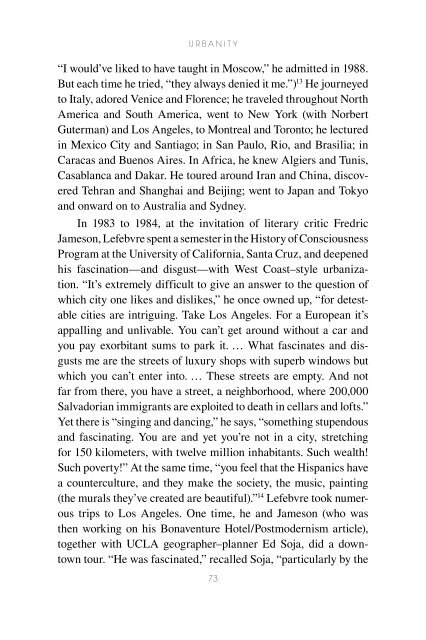Henri Lefebvre: A Critical Introduction - autonomous learning
Henri Lefebvre: A Critical Introduction - autonomous learning
Henri Lefebvre: A Critical Introduction - autonomous learning
You also want an ePaper? Increase the reach of your titles
YUMPU automatically turns print PDFs into web optimized ePapers that Google loves.
U r b a n i t y<br />
“I would’ve liked to have taught in Moscow,” he admitted in 1988.<br />
But each time he tried, “they always denied it me.”) 13 He journeyed<br />
to Italy, adored Venice and Florence; he traveled throughout North<br />
America and South America, went to New York (with Norbert<br />
Guterman) and Los Angeles, to Montreal and Toronto; he lectured<br />
in Mexico City and Santiago; in San Paulo, Rio, and Brasilia; in<br />
Caracas and Buenos Aires. In Africa, he knew Algiers and Tunis,<br />
Casablanca and Dakar. He toured around Iran and China, discovered<br />
Tehran and Shanghai and Beijing; went to Japan and Tokyo<br />
and onward on to Australia and Sydney.<br />
In 1983 to 1984, at the invitation of literary critic Fredric<br />
Jameson, <strong>Lefebvre</strong> spent a semester in the History of Consciousness<br />
Program at the University of California, Santa Cruz, and deepened<br />
his fascination—and disgust—with West Coast–style urbanization.<br />
“It’s extremely difficult to give an answer to the question of<br />
which city one likes and dislikes,” he once owned up, “for detestable<br />
cities are intriguing. Take Los Angeles. For a European it’s<br />
appalling and unlivable. You can’t get around without a car and<br />
you pay exorbitant sums to park it. … What fascinates and disgusts<br />
me are the streets of luxury shops with superb windows but<br />
which you can’t enter into. … These streets are empty. And not<br />
far from there, you have a street, a neighborhood, where 200,000<br />
Salvadorian immigrants are exploited to death in cellars and lofts.”<br />
Yet there is “singing and dancing,” he says, “something stupendous<br />
and fascinating. You are and yet you’re not in a city, stretching<br />
for 150 kilometers, with twelve million inhabitants. Such wealth!<br />
Such poverty!” At the same time, “you feel that the Hispanics have<br />
a counterculture, and they make the society, the music, painting<br />
(the murals they’ve created are beautiful).” 14 <strong>Lefebvre</strong> took numerous<br />
trips to Los Angeles. One time, he and Jameson (who was<br />
then working on his Bonaventure Hotel/Postmodernism article),<br />
together with UCLA geographer–planner Ed Soja, did a downtown<br />
tour. “He was fascinated,” recalled Soja, “particularly by the<br />
73
















